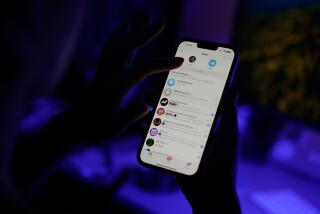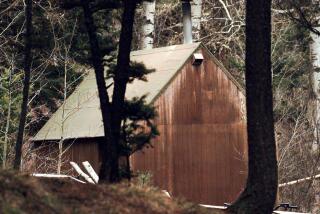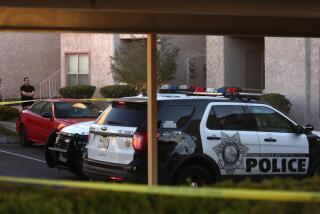FBI Intensifies Hunt for Elusive Unabomber : Probe: Director says agents are hand-delivering copies of terrorist’s manifesto to college professors in hopes they can help find the killer.
- Share via
SAN FRANCISCO — FBI Director Louis J. Freeh said Wednesday that the search for the elusive Unabomber is a top priority and that his agency is intensifying the investigation into the deadly serial bomber.
Freeh’s statement, issued by his Washington office, came as the FBI began hand-delivering the Unabomber’s 35,000-word manifesto to more than 50 professors at universities and colleges nationwide in the hopes that they can help find the terrorist who has killed three people and injured 23 over 17 years.
“The FBI is taking this investigative step in an effort to determine whether that community might recognize the writer’s work or be able to shed light on important or telltale aspects of the manuscript’s general topic, the history of science,” Freeh said in a rare public comment on the case.
In the statement, the FBI also denied that it is using the Unabomber case as a pretext to investigate anarchists, left-wingers or environmentalists. The agency promised to keep files in the Unabomber investigation separate from general FBI investigative files.
Despite a massive search involving more than a hundred agents and thousands of tips from the public, the FBI has been stumped in its efforts to find the elusive terrorist.
Since June, when the Unabomber sent out copies of his manifesto to three publications and a UC Berkeley professor, agents have been poring through the document for clues to the bomber’s identity.
Relying on the documents and the known whereabouts of the terrorist during his 16 bombing attacks, the FBI has pieced together a pattern linking the Unabomber to several universities.
The Times reported Wednesday that the FBI has obtained the lists of student registrations at universities where the Unabomber might have been enrolled and has come up with a handful of former students who fit the pattern of the Unabomber’s movements.
First, the FBI has concluded, the Unabomber was “exposed to the history of science or similar academic disciplines” in the late 1970s in the Chicago area, perhaps while taking classes at Northwestern University or the University of Illinois Circle Campus.
“There are indications the bomber continued his education, formally or informally, in the Salt Lake City area in 1980 and 1981,” Freeh’s statement continued. After that, the bomber apparently had “some sort of contact” with UC Berkeley between 1982 and 1985, the statement said.
It is also possible that the bomber has had “some contact” with other colleges or universities around the country, the FBI said.
One professor the FBI has sought assistance from is Keith R. Benson, a historian of biology at the University of Washington. Benson said he was first contacted by authorities in October, and was called again Tuesday and told that the manifesto was being delivered to him for his review.
Benson said the FBI has asked him to read the essay and look for any terms or themes that might be linked to a particular historian of science or to a university program in the field.
“I think what they’re looking for is any clue about where this individual may be located or may have attended school, based on his particular style of writing,” said Benson, who is executive secretary of the 3,000-member History of Science Society. “The hope is that he may have used some buzzword or language that might be connected with a course or a particular professor.”
Others the FBI are consulting include authors who have written about science and society and professors in related fields, Benson said.
After reading excerpts of the manifesto published Wednesday, Benson said he does not believe the Unabomber was enrolled in a history of science program. While the terrorist clearly knows the field, Benson said his references do not suggest an intimate familiarity with the subject.
“There’s an abundant literature out there on critical studies of science and on the role of technology in modern society, and it may be that he’s just an avid reader of that,” Benson said. “Or he may be someone who hangs around campuses and stopped in on a history of science seminar one time.”
Moreover, Benson said, his writing style, while passable, is not suggestive of a scholar.
“It’s a bit disjointed and it’s too polemical,” Benson said. “His argumentative style is not something one would associate with an academic or someone well along in a program like history of science.”
The FBI said it hopes that analysis of the manuscript will “prompt recollections of persons who may have seen the bomber’s writings at some point over the years.”
The New York Times and the Washington Post, which received copies of the manuscript from the Unabomber, published excerpts from the document in Wednesday’s editions.
The excerpts indicate that the Unabomber is well-educated, with a background in sociology, psychology and leftist ideology.
The Unabomber, who identifies himself as a group called FC, laments the control of the mass media by large organizations and writes: “In order to get our message before the public with some chance of making a lasting impression, we’ve had to kill people,” according to the excerpts published by both papers.
The Unabomber has offered to stop his deadly bombings if either paper prints the full text of his manuscript by late September and then publishes a follow-up statement each year for the next three years. The papers have not decided whether to publish the manifesto.
Paddock reported from San Francisco and Warren reported from Sacramento. Times staff writer Ronald J. Ostrow in Washington contributed to this story.
More to Read
Sign up for Essential California
The most important California stories and recommendations in your inbox every morning.
You may occasionally receive promotional content from the Los Angeles Times.










